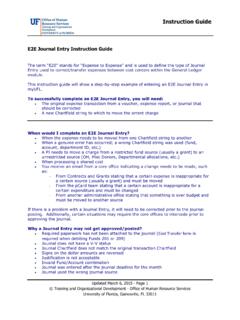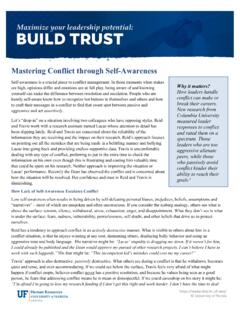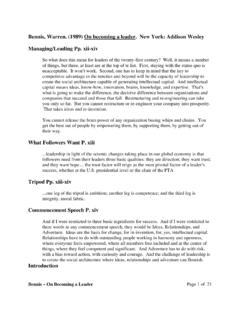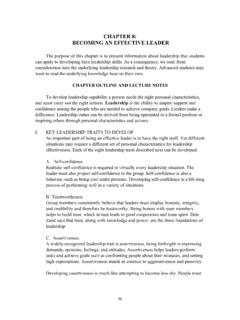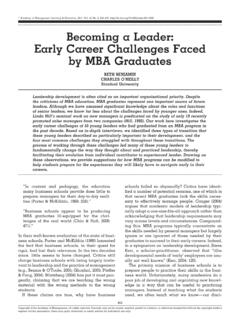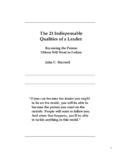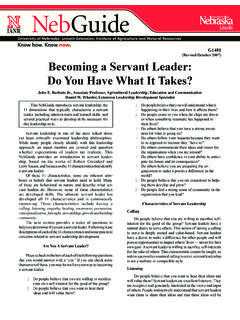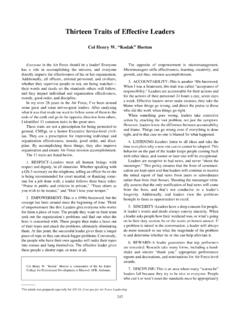Transcription of Becoming an Adaptable Leader - University of Florida
1 University of Florida Becoming an Adaptable Leader The Four Leadership Styles A Leader s style has a direct impact on others. Successful leaders adjust their leadership style based on what s needed by others. The Situational Leadership Model, developed by Ken Blanchard and Paul Hersey, identifies four leadership styles: Directing Coaching Supporting Delegating Each style varies in the amount of directive and supportive behaviors used by the Leader according to the employee s development level and/or the employee s willingness and ability to perform the task. A Closer look at the Leadership Styles As a Leader , how and when to adjust your level of direction and support will vary based on the skill set and motivation of the employee or even the situation. Let s take a closer look at the characteristics of each of the four styles and when these styles may be appropriate to use. Directing This style is high directive/low supportive.
2 The Leader provides structure and closely supervises the employee. When using this style, the Leader g ives instructions on tasks to be completed including specifics on how to complete the assignment. Communication is one way from the Leader to the employee. The Leader solves problems and makes the decisions. This style may be used when an employee is unable to perform the job or task assigned to him or her or lacks the confidence in his or her own abilities. Coaching This style is high directive/high supportive. The Leader provides guidance and explains reasons for decisions and any background information the employee may find helpful to complete the job or project. This style is best used when an employee is willing and confident but may be lacking the knowledge or skills to complete the job or assignment. Supporting This style is high supportive/low directive. The Leader provides praise, encouragement and recognition to the employee.
3 When using this style, the Leader actively listens to concerns the employee may be having, provides a high amount Why it matters? Leadership problems often occur when the leadership style does not fit a situation. An experienced and dedicated employee does not want to be closely supervised and controlled. A new employee with no experience does not want to be given a job to do without training and support. Delegation of responsibility to a person not prepared to handle the responsibility frustrates the worker and disappoints the employer. What may appear superficially to be an employee attitude problem is in fact a leadership problem caused by the Leader s inappropriate leadership style. University of Florida of support, promotes discussion, and shares responsibility for decision-making. This style may be used when an employee is capable of performing the job or task but lacks the willingness or confidence to do so.
4 Delegating This style is low supportive/low directive and allows for a high level of employee autonomy. The Leader delegates responsibility to the employee and may regularly check-in to see how the work is progressing. This style is best used when the employee is competent and capable of completing the job or task in addition to being willing and confident in his or her abilities. The Benefits and Challenges of Each Style Typically, one of the styles comes more naturally, and as such, leaders have a tendency to prefer one style over another. Though each of the styles possesses benefits, leaders should be cautious that overuse of one particular style can create challenges. The ability to overcome our preferred default tendency and adapt our leadership style to the situation is the key to helping employees grow as their abilities, confidence and willingness increase. The directing style provides an employee with specific details and clearly defined expectations.
5 This can be very helpful, especially for a new employee. Overuse of directing, however, can create a lack of autonomy and the focus may become more on the task than the employee. This may give the perception that the Leader is a micromanager and can cultivate a habit where the employee waits to be told what to do next. Over time, the exclusive use of directing may lead an employee to feel an absence of trust in his or her relationship with the Leader . The coaching style can benefit a willing and capable employee by helping him or her learn and understand processes and systems that are in place. It can also provide the employee with necessary background information needed to complete a task or project. Overuse may keep an employee too dependent on the manager and prevent the employee from developing ownership of his or her role. Exclusive use of coaching can unintentionally decrease productivity due to the Leader s always providing too much explanation or background information.
6 University of Florida The supporting style encourages growth and development and can increase both group and individual capacity. Overuse of this style could frustrate an employee especially a high performer who may feel like the constant praise is not genuine or may misinterpret shared decision-making as a lack of trust. The delegating style empowers an employee and encourages growth and development. It also allows a Leader to be more productive because it frees up some of his or her time. The challenge of using delegating exclusively is that it could lead to the employee s Becoming burned-out, especially if he or she is the one to whom you delegate most often. This style would also be inappropriate to use with a new employee who most likely would feel overwhelmed due to the lack of guidance and direction. Diagnose, then Adapt In his book The Situational Leader , Dr. Paul Hersey states in most situations, with individuals or groups, there is no all-purpose leadership style.
7 Effective leaders study the situation and adopt the appropriate leadership style. Step one is diagnosis. Create just a little bit of space to observe the person and circumstances. This may include asking questions, such as, What s your take on this situation? .. How would you solve this problem? .. I sense you re hesitant; what are your concerns? .. Is this something you feel comfortable doing? These types of questions can help you detect the person s level of willingness, confidence, and ability. Understanding the styles and diagnosing the situation is not enough. To be truly effective a Leader must adjust or alter his or her style to meet the needs of the other person; adapting your style follows diagnosis. Understanding the willingness and ability of the employee gives insight into how best to alter the amount of directive and supportive behavior you provide. As competence and abilities change, so will levels of enthusiasm and commitment.
8 leaders should be careful to not stereotype someone based on their initial level of willingness and ability. As an employee grows in his or her role a Leader may spend more or less time in providing direction and/or support. This does not mean that the Leader will never again use this style with the person, but it may only be used in limited situations. leaders should cultivate the habit of diagnosing on a regular basis to ensure they are utilizing the style that fits best. Conclusion At the core of Situational Leadership is the understanding that leadership is not one size fits all. leaders must be able to adapt based on the ever-changing environment and needs of others. By practicing Situational Leadership, leaders can build effective relationships with others based on mutual trust and respect while developing competence and building commitment in others. References: Blanchard, Kenneth H.
9 , Zigarmi, Drea, and Zigarmi, Patricia. 1985. Leadership and the One Minute Manager: Increasing Effectiveness Through Situational Leadership. New York, NY: Morrow. Hersey, Paul. 1984. The Situational Leader . Escondido, CA: Center for Leadership Studies.




